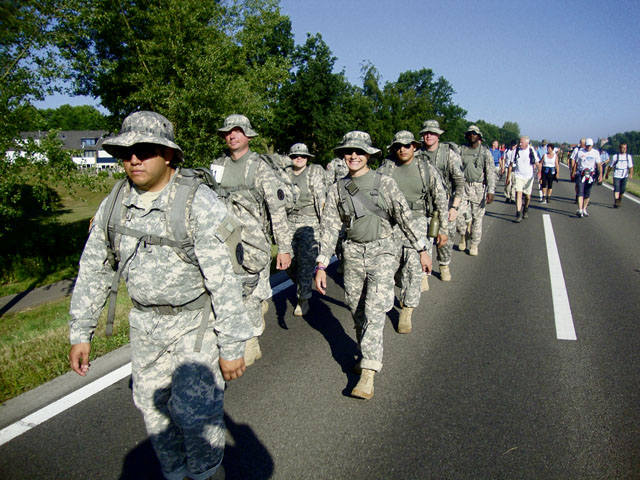
A combined team from Landstuhl Regional Medical Center and U.S. Army Public Health Command Region-Europe march alongside approximately 40,000 marchers participating in the second day of the International Four Days Marches Nijmegen in Holland.
Since November 2012, a small team of dedicated Soldiers have been crawling out of bed in the early hours two to three times a week to march with each other at times over 25 miles. This sacrifice was in preparation for one of the most arduous and intensely celebrated annual events of modern times — the International Four Days Marches Nijmegen.
The first “Vierdaagse,” or four-day march, was held in 1909 as a way of keeping the Dutch army fit after the introduction of motor vehicles. Depending on the age group and category, participants must walk 30, 40 or 50 kilometers each day for four days. Originally a military event with a few civilians, it now is a mainly civilian event. Numbers have risen in recent years, with more than 40,000 taking part, including about 5,000 military members. It is now the world’s largest walking event.
On July 16, a small contingent of 17 Soldiers from a combined group from Landstuhl Regional Medical Center and U.S. Army Public Health Command Region-Europe joined 31 other countries and 48,000 participants for the first day of this march. Lowland dikes and small villages along the route were crammed with thousands of supporters who cheered everyone along the roadsides. Friendly, smiling faces filled almost every yard and sidewalk along the route. The cobblestones at the end of this day were not the only hardship as the team lost two team members to heat related injuries.
Day Two’s route was as intense as the first, with a swing through downtown Nijmegen once again.
With 48,000 participants filling the street, this caused the team to use cadence calling skills and discipline while marching to drive through the slower crowds.
Many of the blisters and fatigue from the previous day were now becoming a factor in finishing as a team. The pace at which the unit walked was complicated by the fact that the team was required to pass each checkpoint gate together and finish as a team. This meant the team had to march in formation, and at most times, to stay in step. The constant stream of children giving them high fives and asking for souvenirs or candy was never-ending during all four days.
Day Three’s route was capped by seven “hills” that to the local Dutch seem significant, but to this highly prepared team of professional Soldiers were nothing more than normal flat land found around their local training area. The team again marched to the finish with style. Day Three was done and the team had time to mull over their fate with their legs up. After having already marched more than 78 miles in three days, the knowledge that they had at least 25 more miles to the finish started to wear heavily on their hearts and souls.
Day Four’s start was electric. The combination of starting earlier than other days (4 a.m.) and the fact that the team remained intact increased team morale and enthusiasm. The fourth day was also the beginning of the end. As the team limped along the road, it was obvious this day was going to be even more intensely supported by the people along the route than the previous days. The party atmosphere increased as the team marched closer to downtown Nijmegen. The crowds began to press harder on the participants until it seemed impossible to get through. Beer, soda, juice and Champagne in little plastic cups were thrust at the team as they pushed harder to the finish line.
Writing a definition of the finish is impossible. It is one of those events in life that needs to be seen and experienced to understand its scope. There were more than 300,000 people jammed along the route as the team pressed through the crowd to finish just in time for the 4:55 p.m. finale with only five minutes to spare. The teamwork and motivation of this small and dedicated group of LRMC and PHC Soldiers was rewarded with the team award and each participant receiving their first Nijmegen March award.
Vince Lombardi once stated, “Fatigue makes cowards of us all.” If this is true, the men and women on this march displayed personal courage, steadfast dedication and loyalty to their battle buddies to complete the goal set in front of them.







